Biology
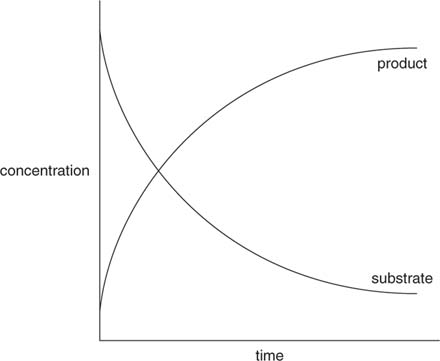 Measurement of the rate of formation of the product or the rate of disappearance of the substrate.
Measurement of the rate of formation of the product or the rate of disappearance of the substrate.
1. Measurement of the rate of formation of O2 in the reaction:

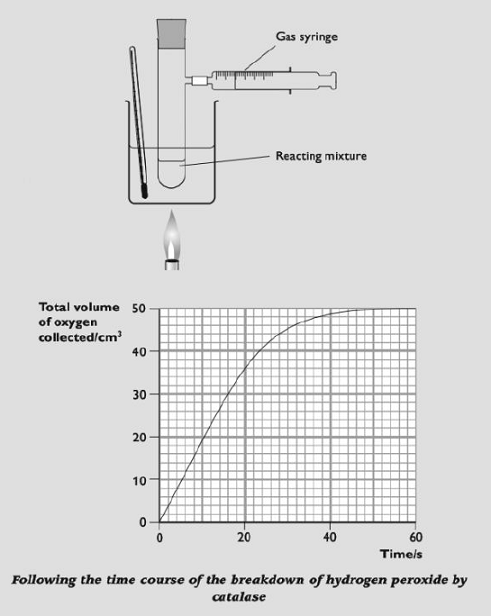
2. Measurement of the rate of disappearance of starch in the reaction:
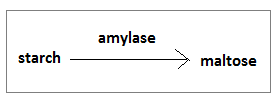
To obtain quantitative results, use a colorimeter.
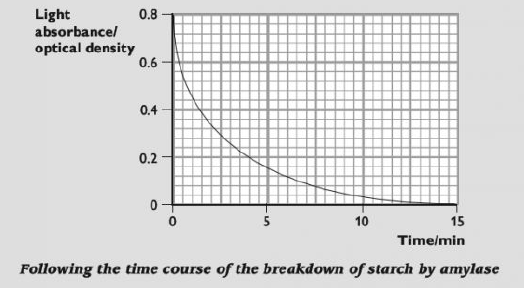
- #22 Summary Of Enzymes
1 Enzymes are globular proteins which catalyse metabolic reactions. 2 Each enzyme has an active site with a specific shape, into which the substrate molecule or molecules fit precisely. This is the lock and key hypothesis ? the substrate is...
- #20.factors Affecting The Rate Of Enzyme-catalysed Reactions
These factors are: - Temperature - pH - Enzyme concentration - Substrate concentration - Inhibitor concentration When an enzyme solution is added to a solution of its substrate, the molecules collide. With time, the quantity of substrate...
- #17.2 Enzymes - Syllabus 2016
3.1 Mode of action of enzymes 3.2 Factors that affect enzyme action Enzymes are essential for life to exist. Their mode of action and the factors that affect their activity are explored in this section. Prior...
- #10.tests For Carbohydrates
Tests for Reducing sugars, Non-reducing sugar and Starch. 1. Reducing sugar (Benedict's test) All monosaccharides and most disaccharides (except sucrose) will reduce blue CuSO4(II), producing a precipitate of red Cu2O(I).Benedict?s...
- Amylase
Term: amylaseLiterally meaning: ?the enzyme that catalyses starch ?Origin: Anc Greek??????/amylon(=starch) >?/a(privative, ?not?) + ????/myle(=millstone) because this hydrocarbonate (eg from potatoes) was not ground at the mill as bread flour...
Biology
#19. Following the course of an enzyme-catalysed reaction

1. Measurement of the rate of formation of O2 in the reaction:

- Mash up some biological material like potato tuber or celery stalks, mix them with water and filter the mixture to obtain a solution containing catalases.
- Add the mixture to H2O2 (hydrogen peroxide) in a test tube. Use small tubes --> not too much gas in the tube above the liquid.
- Collect the gas in a gas syringe and recording the volume every minute until the reaction stops.
Note - You can replace the gas syringe by an inverted measuring cylinder over water.

2. Measurement of the rate of disappearance of starch in the reaction:

- Add amylase solution to starch suspension in a test-tube.
- Take samples of the reacting mixture at regular time intervals, and test for the presence of starch using iodine in KI solution.
- When starch is present, iodine is dark blue.
- If the blue colour lightens, starch is breaking down.
- When there is no starch, the iodine solution will remain orange-brown.
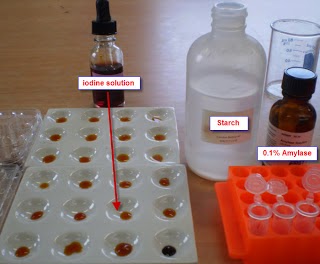 |
- Put some of the iodine solution into one of the colorimeter tubes, place it in the colorimeter and adjust the dial to give a reading of 0. This is your standard, with no starch.
- Every minute, take a sample of the liquid from the starch-amylase mixture and add it to a clean colorimeter tube containing iodine solution. Mix thoroughly, then measure the light absorbance.
- The darker the blue-black colour, the greater the absorbance, and the greater the concentration of starch.

| Syllabus 2015 (c) [PA] follow the progress of an enzyme-catalysed reaction by measuring rates of formation of products (for example, using catalase) or rates of disappearance of substrate (for example, using amylase); |
Syllabus 2016 d) investigate the progress of an enzyme-catalysed reaction by measuring rates of formation of products (for example, using catalase) or rates of disappearance of substrate (for example, using amylase) |
- #22 Summary Of Enzymes
1 Enzymes are globular proteins which catalyse metabolic reactions. 2 Each enzyme has an active site with a specific shape, into which the substrate molecule or molecules fit precisely. This is the lock and key hypothesis ? the substrate is...
- #20.factors Affecting The Rate Of Enzyme-catalysed Reactions
These factors are: - Temperature - pH - Enzyme concentration - Substrate concentration - Inhibitor concentration When an enzyme solution is added to a solution of its substrate, the molecules collide. With time, the quantity of substrate...
- #17.2 Enzymes - Syllabus 2016
3.1 Mode of action of enzymes 3.2 Factors that affect enzyme action Enzymes are essential for life to exist. Their mode of action and the factors that affect their activity are explored in this section. Prior...
- #10.tests For Carbohydrates
Tests for Reducing sugars, Non-reducing sugar and Starch. 1. Reducing sugar (Benedict's test) All monosaccharides and most disaccharides (except sucrose) will reduce blue CuSO4(II), producing a precipitate of red Cu2O(I).Benedict?s...
- Amylase
Term: amylaseLiterally meaning: ?the enzyme that catalyses starch ?Origin: Anc Greek??????/amylon(=starch) >?/a(privative, ?not?) + ????/myle(=millstone) because this hydrocarbonate (eg from potatoes) was not ground at the mill as bread flour...
